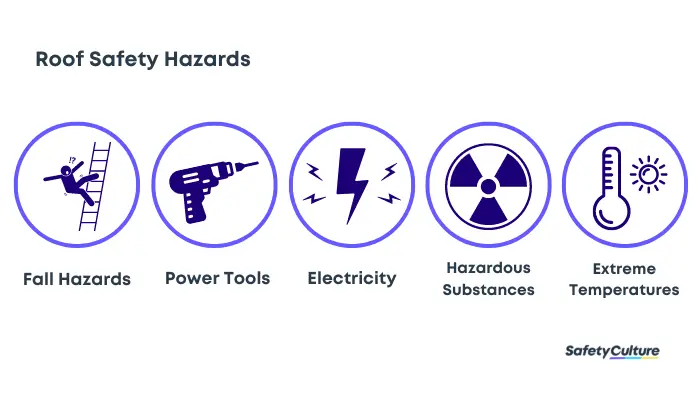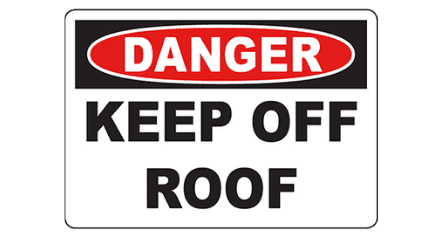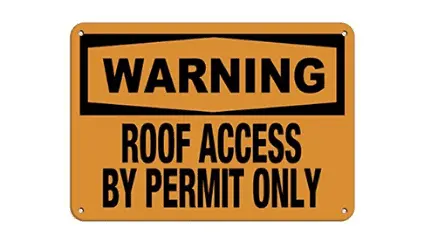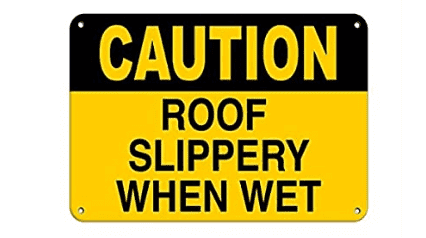What is Roof Safety?
Roof safety refers to the system and practice of implementing preventive and safety measures when performing work and repairs on rooftops. Roof safety should be practiced while on the job to avoid personal injuries and structural damage. Since performing roof work exposes workers to various risks including falls, roof safety measures must be strictly adhered to.
5 Common Rooftop Safety Hazards

5 Common Roof Safety Hazards
To protect roofers, contractors, and subcontractors from serious injuries and fatalities, it’s important to identify hazards when working on rooftops and follow critical safety steps to control them. Below are the most common rooftop hazards that should be identified and controlled to keep roofers safe:
- Fall Hazards – Always watch out for fall hazards when working at heights and prepare yourself with the right harnessing and fall protection gear before working.
- Power Tools – If improperly used at heights, power tools can inflict serious damage to workers as well as cause slips and falls. Hence, ensure your team is properly trained to handle power tools.
- Electricity – Workers, especially those on rooftops and near power lines, are highly exposed to electrical hazards. To control possible causes of electrocution and prevent accidents, conduct regular electrical safety checks.
- Hazardous Substances – Check for common hazardous substances, such as asbestos, paint fumes, and other harmful chemicals, that may pose risks to workers on-site and take appropriate action including proper storage and safe handling of hazardous substances.
- Extreme Temperatures – Workers must be protected from the dangers of extreme temperature by identifying the risks brought by equipment or current weather conditions. Have your team perform a toolbox talk before your shift to decide whether you should commence work for the day.
Improve your EHS Management
Cultivate a safe working environment and streamline compliance with our EHS solutions.
Explore nowRoof Safety Signs and Their Meaning
According to OSHA, safety signs are generally categorized into three types—danger signs, warning signs, and caution signs. When working on rooftops, roofers will usually encounter the following examples of roof safety signs and what they should do:

Danger Sign
When there is a roof safety danger sign, there are immediate hazardous conditions that will lead to serious injury and death if not avoided. Upon seeing this sign before any roofing work, avoid it at all costs.

Warning Sign
When there’s a roof safety warning sign, there are existing life-threatening hazards that can lead to serious injury or death. Accessing roofs by permit means that only authorized personnel or trained employees can be on them. Warning signs represent a hazard level between danger and caution, needing specific precautionary measures to be taken.

Caution Sign
When there’s a roof safety caution sign, there are minor hazard situations where a non-immediate or potential hazard or unsafe practice presents a lesser threat of employee injury. Roofers should be mindful of caution signs and apply necessary control measures in any roofing work.
Top 10 Roofing Safety Tips
- Always begin with your 5-10 minute pre-start talk:Discuss common hazards present (like the common hazards above), assess the condition of the work area, confirm that proper permits have been secured, and encourage the team to verbalize the safety tips to follow.
- Work only during good weather conditions and avoid extreme heat/cold: Better side with caution and always wait for ideal weather before you begin roofing work to avoid slips and falls.
- Ladders should be stable and properly secured or tied off: Always ensure there are enough ladders and scaffolding for the job and that they’re all safe to use. Check your ladders for safety, repair, or replacement needs to prevent fatal accidents or injuries.
- Wear proper Personal Protective Equipment (PPE): Wearing adequate PPE such as helmets, shoes with traction, and fall protection harnesses can help save you when slips and falls occur. Perform regular PPE checks to ensure your team is properly equipped.
- Carefully position ropes and extension cords so they’re not underfoot: When not properly handled, ropes and cords can hinder workers’ movements and cause fatal accidents. Always follow proper use of ropes, cords, and safety harnesses.
- Sweep the roof before and after work and ensure it’s clear of dirt and debris: Always keep the roof clean and free of items that can cause accidents or materials that can hinder the roof’s visibility
- Use guardrails whenever possible: Guardrails serve as a visual and physical barrier that protects workers from falls. It reduces the risk of injury and death from working on roofs.
- Skylights should be guarded appropriately: Skylights and other openings on roofs should be properly covered and labeled with visible warning signs to prevent workers from leaning on or falling into them.
- Be careful of slate and tile roofs: Workers must be properly trained and have enough experience to work on slate and tile roofs as these are considered major slip hazards.
- Signages should be visible in your work area: People around the work area should always be aware of roofing work in the vicinity by using visible warning signs to prevent injury or accidents with staff working on-site or from falling debris.
Create your own Roof Safety Checklist
Build from scratch or choose from our collection of free, ready-to-download, and customizable templates.
Browse Roof Safety ChecklistsRoof Safety Topics for Meetings
As the topmost safety precaution for working on roofs, pre-start talks should be performed. Listed below are sample roof safety topics for meetings prior to commencing roofing work:
- Working with Skylights and Roof Openings
- Basic Roof Housekeeping Standards
- Demonstrating the Proper Operation of Roof Cutters and Power Brooms
- Safety Measures for Job-built Ladders
- Identifying Potential Heat Illnesses and How to Avoid Them
- Pre-use Checks for Specific Roofing Equipment
- Proactively Preventing Horseplay to Avoid Slips, Trips, and Falls
FAQs About Roof Safety
Roofers typically use a variety of safety equipment and gears to protect themselves while working at heights. These safety gear can include items such as harnesses, safety ropes, hard hats, safety glasses, slip-resistant shoes, gloves, safety nets, and guardrails.
Yes, OSHA requires harnesses for workers working on a steep-slope roof with unprotected sides and edges 6 feet or more above lower levels on construction sites—including on roofs. Body harnesses are part of a bigger system of Personal Fall Arrest (PFA) which also includes anchorage, connectors, lanyards, deceleration devices, and lifelines as necessary.
The most common accidents reported by roofers are slips, trips, and falls, according to NIOSH. Other common roofing accidents include struck-by accidents, cuts and puncture wounds, burns, electrocution, heat exhaustion, traumatic brain injuries, and respiratory problems, among others.
It can vary based on several factors, including the climate, weather patterns, and the specific needs of your roof. However, there are a few general recommendations to consider on when to conduct a roof inspection:
- Spring – Spring inspections let you assess any potential damage caused by harsh weather conditions such as snow, ice, or strong winds.
- Fall – Inspecting your roof in the fall allows you to address any potential problems and ensure your roof is prepared for the upcoming winter season, including heavy rainfall, snow, and ice.
- Before and after severe weather conditions – This allows you to assess any damage beforehand and address it promptly after the severe weather has passed.
- Regularly scheduled inspections – Aim for at least one or two inspections per year to catch any issues early on and prevent them from escalating.
Employers must protect workers from recognized hazards. Depending on the associated hazards, some of the PPE that may be required for working on a roof can include, but isn’t limited to the following:
- non-slip footwear
- hard hat
- gloves
- eye protection like safety glasses and visors
- hearing protection like earplugs and muffs
- fall protection like safety harnesses and lanyards
- respiratory protection
- wet weather gear




